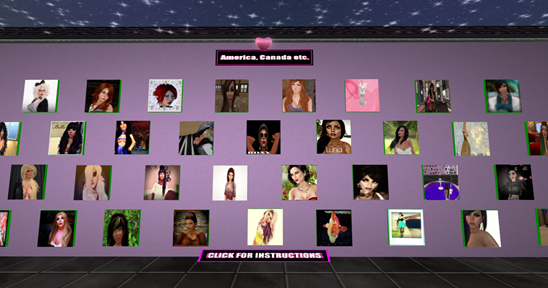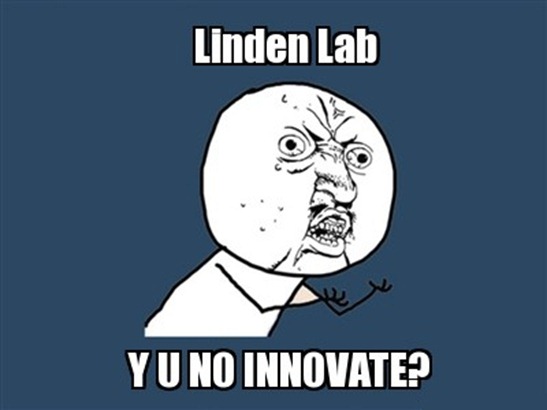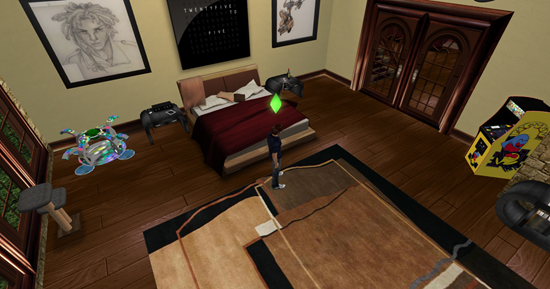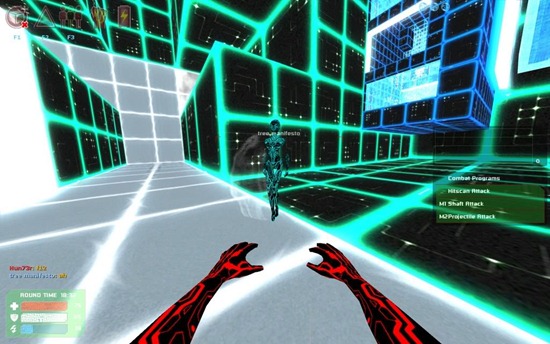Communication and empathy in #SecondLife
In my typical fashion, I present a substantial post today concerning the topic of choice: Communication and Empathy in Second Life. It’s somewhat of a “dating” post, but it goes into a lot more than that at the root. I thought it was a fitting post for the last day of the year, December 31st 2012. We’ve made it past the end of the world, so today I’d like to outline my hopes for a better (virtual) world going forward. Of course, we have to explore the complete context to get to that point… so let’s begin.
I’ve spent a lot of years in virtual worlds, and the earliest memory I have of them is a situation in Blaxxun Contact when I was about 17 years old. Of course, I had spent a lot of time with VRML systems and BBS software, but I believe Blaxxun Contact was my first foray into multi-user spaces (Cybertown). At the time, I had seen them much like anyone else would coming in for the first time – maybe a game or a communication platform that happened to be in a virtual 3D space.
MoriRose and Myself
Here in the virtual world, we could digitally exist much like we already were in chat rooms but with the added benefit of the full three dimensional space. We were no longer just disembodied chat text on the screen, but inhabiting a spatial context. What I found early on is that the situations today aren’t very different than they used to be when it comes to communication and empathetic attachment.
Back then, the situation unfolded quite the same as it does today on a daily basis in the dating or (for lack of better wording) relationship arena. My friend at the time was married in real life and had a couple of kids, and upon seeing this new virtual world that I was involved with, wanted me to show him around. He was truly intrigued by the novel form of online communication and existence.
Over the course of a number of months, he had really gotten into Cybertown heavily, and met some wonderful people. The problem (I believe) is when he ran into another woman whereby it progressed into an emotional attachment and relationship that was bigger than just a friendship.
I remember telling him that you can’t justify cheating on your wife with somebody else simply by brushing it off as a game. Of course, this sounds all too familiar today in the space of Second Life where on a daily basis I hear about husbands, wives, girlfriends and boyfriends doing just that to their partners. He used the all too common excuse on his wife that you probably have used yourself or have heard used time and again – except his wife didn’t buy the line of bullshit and divorced him.
“It’s just a game.”
I hear that far too often today. My friend Quinn in-world came into Second Life solely to find out what it was all about. Her boyfriend apparently had a partner for about about 5 years now, and well before he met Quinn in RL through Match.com as a dating service. They were a couple for awhile before he finally told her his “little secret” of Second Life.
I think that’s your first cue that you are probably doing something disingenuous, if you feel a need to hide your actions. This goes for trying to separate yourself in multiple ALT accounts as well. In that context, it’s just cheating on your spouse or loved one(s). There is nothing more to it than that, no matter how much we like to excuse it or spin it as something else.
There have only been two instances whereby I saw a sincere need to have an ALT, and both times it was to protect the identity of the main account and the person behind it. So under that premise, I would say it’s an honest reasoning. However, more often than not it’s for a dishonest reason, and that is what bothers me.
She came into Second Life because her boyfriend gave her that line “Oh, it’s just a game… don’t worry”. What she found out was quite the contrary. I’m pretty sure she had the (mis)fortune of running into me early on when she came to Second Life… her boyfriend didn’t seem to have any problem with her coming into Second Life based on the premise of her being completely new at it that it would take her quite some time to really become accustomed to it and get her avatar together in a way that would pose some threat to him.
His secret, he figured, was totally safe and he had nothing to worry about. She wasn’t going to get hit on, wasn’t going to find herself a boyfriend in SL, and she didn’t even know the first thing about how to go about looking up profiles and such. No… she just sat at Muddy’s and listened to music in her noobie avatar.
And then she met me…
and I more or less told her what to expect, how he was playing her and likely another woman, and for lack of better wording… cheating on her. What was more messed up was that because he had been partnered to the other woman years before he met Quinn through Match.com, I told Quinn that by technicality she was the other woman and he was cheating on his partner with her.
My goal then became to level the playing field on her behalf. I set up her avatar and made her into a drop-dead gorgeous bombshell knockout. So much so, that stepping foot in Wet Willies got her bombarded with IMs from guys complimenting her on her avatar as “the best they’ve seen in years”. All that before she managed to get to the door.
It was true, I had gotten her avatar into what amounts to be a black haired Heather Locklear. Worked on shape, found the right skin to go with her looks (in real life). In real life, she’s quite the looker so it wasn’t much of an exaggeration in her avatar. That alone pissed me off even more about him because there she was… not 5 feet away in real life, and damned good looking, and he chose the virtual girl over her.
Then, once I had set her avatar up and made her the center of attention, I asked her what her boyfriend’s name in SL was, but she didn’t know the full name. He did, however, tell her the name of the woman he was partnered too and took great pains to keep Quinn from stepping foot anywhere near his sports club, her club, or having them two meeting. After she told me her name, I saw the partnership and looked at his profile… and immediately knew why. He was announcing to the world that his partner was his one and only (which I can get the collective lie aspect or RP) but then went ahead and shot his “It’s just a game” excuse right out the window by stating in his public profile that his partner was his only love in SL and RL.
Oh, the shit hit the fan.
All those business trips he was taking suddenly added up in her head the moment I asked her if he brought the laptop and had skype, what would possibly stop him from turning on video with her while he was away to prove to his partner he was by himself? Hell… what stops him from calling Quinn on the laptop and video chatting with her while he’s away?
The answer was that he was too busy with his virtual girlfriend to pay any attention to his real girlfriend.
Quinn asked me if there was a way to see chat logs in Firestorm, and being honest I told her how but warned her that what she would find wouldn’t be good. He was probably giving that girl his phone number, email, and every real world contact he had, telling her she meant the world to him… and of course, she went ahead and read the chat logs anyway.
That’s exactly what he was doing… telling her how much she means to him, one day they’ll be together, until then here’s his contact information and he wanted her to txt, email, call, and whatever else…
Quinn was rightfully pissed.
But here’s the kicker: I had done such a good job with her avatar and getting her up to speed on SL in such a short time, that she now looked infinitely better than his own partner of ~5 years, and was becoming nervous and jealous. He specifically went out to make an ALT just to spend time with her outside of his main account which was partnered, and now he was reciprocally cheating between two women in two worlds.
Whatever happens from there is really up to her. I suspect she’ll just go find a virtual boyfriend and pretend he’s not cheating on her. They’ll lead separate virtual lives to escape the fact that their real life together is all but shot to shit.
When confronted with those chat logs, and busted beyond red-handed… all he had to say for himself when she said “We need to talk…” was “There’s nothing to talk about. I have work to get done.” and completely blew her off. They did finally talk later on, but about what I couldn’t say. Based on how he’s been acting so far, I’d essentially believe he just gave her the long line of bullshit and justifications, and told her to go have her own virtual life and leave his alone.
More or less, it was a situation of: Yeah, I’m cheating on you and there’s nothing you’re going to do to stop me.
That is pure arrogance.
But we get cocky like that when we’ve convinced ourselves we’re untouchable and without real consequences.
Is it just a game?
I stand firmly on the side of it not being “just a game”. Yes, you can lead a made-up life in virtual worlds, play a character, and explore things you wouldn’t in real life. But along the lines you are still dealing predominantly with very real people and for that there is the notion of emotional attachment and bonding.
When I first joined Second Life about 5 years ago, I mostly saw profiles that said they were characters or that the avatar was separate from the person. I saw a lot of selfish and destructive behavior from that phase of Second Life, and to this day I still do.
However, something I’ve been noticing more lately is that profiles are beginning to say that there is respect, and honesty, and there are real people behind the avatars and that we should never forget that. Aside from the typical “no drama” and “no bullshit’ sort of lines… people are coming to terms with the empathetic side of virtual worlds, realizing it’s not “just a game”.
Sure there are plenty of people who continue to abuse that excuse for obscenely bad behavior, but I hold out hope that it’s shifting into a minority goring forward as enough people get burned by those emotional attachments and realize something they were trying all along to ignore.
Emotion is Real Life
Unless you are specifically laying out the ground rules of roleplaying and specifically saying “this is just a character and nothing more” you are creating an emotional bond which is the same as if you were dealing with the person in real life.
Even when you are interacting under the guise of a “character” you are still interacting with somebody on the other end of a keyboard who has feelings, emotions, wants and needs. I’ve heard quite a lot about “dating” in Second Life and the shallow attitudes attached to it along the way.
“If you wanted to seriously date, why are you in Second Life? That’s what dating sites like Match.com or eHarmony are for!”
Are they, now? You’ve just read the story of Quinn, so tell me if Match.com or eHarmony are more effective at dating than Second Life. I’ve found that the means of communication is more immersive and robust in Second Life than in a typical scenario of Match.com or eHarmony. After all, how is it more acceptable to think a flat page with a simple bio and some basic stats is better than spending time in Second Life getting to know people?
But then again, that sentiment that people use against me to discredit, also (unwittingly) shoots their own interaction to shit. After all, if you’re in a bad relationship in real life or are unhappy to begin with, why the hell are you using Second Life as an escape if you consider it less worthy of your acceptance in emotional roles and connections than a website like eHarmony?
I just call it out for what it is… a communication and interaction platform that allows for immersive experiences including, but not limited to, romantic. You can’t really discredit a virtual world as less appropriate for emotional and romantic encounters if that’s exactly what you (yourself) are utilizing it for as a surrogate to escape a bad relationship situation in real life.
I’ve personally had roughly the same results in and out of virtual worlds when it comes to dating or building relationships romantically. So to me… I don’t see the difference between the two except to say it’s like a mirror image.
In real life we start on the premise of physical attraction and build emotional attraction and compatibility. In the virtual world, we start on the emotional/empathetic attraction and eventually get to the physical. Most never seem to get to the physical part in much the same way as in real life quite a few relationships die out for lack of emotional/empathetic connection.
Just ask the unhappily married man/woman in Second Life who is playing the part of the virtual wife/husband. The married but separated couple who turn to the virtual world to play out a happy relationship instead of resolving their real life issues first and foremost. The couple who is roleplaying with virtual children and the happy home. Which again brings up the question of adults playing as children in Second Life in virtual families. A lot of the time it has an underlying premise that they are trying to make up for something that they are lacking in real life.
I’ve been in and out of the dating centers of Second Life for quite awhile now, and have read all manner of profile cards that people write on their boards. I’ve been on countless dates where at some point it comes out that they are not single but married… or in a bad marriage… or whatever the case may be. I’ve played the sympathetic ear countless times and given the best advice I could give to them in their situations, like a true friend would.
Some take the advice to heart, and others choose to continue trying to turn a blind eye to the real life situation which brought them into Second Life looking for escape. Real life is hard… no doubt about it. You actually have to work at relationships, and you can’t be perfect. You have to deal with rejection a lot, or circumstances which would otherwise not allow you to have something more until you reconciled your past or unhappy present situation.
I suppose that’s why so many people have a folder full of fake pictures they give to people in-world when asked what they look like. There is that insecurity up front, and probably one of the underlying reasons why they are in Second Life to escape. They may be great people emotionally and intellectually, but maybe they don’t live up to the fantasy while the fantasy version of themselves is preferable. So they just keep living the fantasy and have resolved to accept the short term illusion over long term reality.
In a lot of cases, I completely understand that a virtual world existence is all some will ever get in order to lead a “normal” life. Plenty of people who are terminally ill or bed-bound. In that case, it is a good way to relieve that situation when there is truly no other option in real life. But then there is the other side of that coin where there isn’t a real life barrier but people still use virtual worlds as the escape anyway – they justify it the same as the terminally ill person who literally cannot change their real life circumstance. To me, that’s disingenuous at best. The person who cannot change their circumstances in real life really has no other recourse and would kill to have the opportunity to change it that so many waste when they are perfectly capable.
When you are in a virtual world, you are still building empathetic connection to others through your interactions. So when you are “dating” in a virtual sense, emoting, or using the XCITE! furniture for all it’s worth, you are building an emotional connection that is indistinguishable in your mind than what you would get if you were to do any of that in real life.
You end up falling in love.
Jewlie Diesel and Sanlayan Texan in Second Life.
So then, there is the opposite end of the spectrum where I tell you about my in-world sister Jewlie Diesel and her partner San Texan. They met in Second Life awhile back, became partnered, and are a couple in real life as well. Currently they are talking about marriage in real life, and he is going to propose. This is what I set the bar at in regards to relationships in Second Life. Two people who honestly come together, get to know each other, and aren’t trying to bullshit each other – who (if things continue to work out and you fall in love) decide they are really in love and want to continue further. Two people who aren’t trying to hold up a façade, and sincerely want something long term.
Now, I’m not saying relationships in Second Life have to end in real life marriage. I’m saying that if it’s an honest relationship with sincere intentions, that you’ll progress in a healthy manner and not blow up in some drama filled mushroom cloud of bullshit and deceit. I think in the end, what I really believe in is that this situation (with Jewlie and San) isn’t as far fetched as it is, and that this is the sort of thing I would aspire to with my own intentions.
But for those who are going into those interactions with a degree of separation, you have to admit here and now that it is a selfish sort of interaction. It’s right up front based on a lie or fabrication for the purpose of simply using somebody else for your own wants, needs, or whatever with little regard for others. Some people go into it with the fabrication up front, while others are just openly and brazenly wearing that fact on their sleeve like there is nothing wrong with it.
If I took the words “in Second Life” out of the sentence, you know it wouldn’t fly if I said “I’m unhappily married, so I’m dating and romantically involved with other people –“. Really, all I’m doing is removing the mode of communication and leaving the rest of the situation.
That’s why I don’t buy the line “It’s just a game”.
Of course, there are plenty of people who will argue from the point of Open Relationships, etc saying that somebody who truly loves them will be there for them all the time when they are only there part of the time. That’s about what it boils down to if you think about it.
I’m under the impression that if I cannot make somebody happy giving them my all, then I wouldn’t expect to give my all and get a fraction in return. People should be happy… but not on a lopsided basis of all in and 1/4 back in return. People often say “Well, you’re just jealous…” and my reply is “No, you’re just being selfish wanting it all and expecting to give a fraction to them in return.”
That’s not a full relationship… that’s a long term agreement to be friends with benefits. Much in the same way as I had a conversation recently with somebody who is poly and was heartbroken when a boyfriend she had left her for his wife… to work on his marriage. All I could say is that I have no sympathy for her in that situation. He did the right thing and her being the mistress (at best) doesn’t really get the right to be broken up about it.
She saw it differently, obviously… and we continue to agree to disagree for the sake of keeping a friendship. Otherwise, she is quite an amazing person.
But if it works for those couples, so be it. I’m monogamous because I believe in giving the one I love my absolute all and I wouldn’t dream of treating that woman like she meant less than 100% of my love and affection. Of course, I expect that in return…
Degrees of Separation
One of the conversations I’ve had with Dr. Gilbert (Psychology Professor at Loyola Marymount University) has to do with this whole degree of separation between person and persona, as well as what differentiates the means of communication to create that separation.
We would talk extensively about why we would treat somebody on the phone like a real person but then create the degree of separation in our virtual persona. We’re not quite sure why this happens, but I offered a bit of insight into it when he was writing one of his papers in that I suggested maybe it’s because of the “It’s just a game” justification.
In a virtual world like Second Life, there is a much higher degree of empathetic attachment and connection versus talking to somebody on the phone, email, or just a text chat. And yet, it is puzzling that we often consider virtual worlds, the people which inhabit them, and the interactions, as less valuable or real than lesser and more detached forms of communication.
There is a higher degree of immersion with virtual worlds communication, and the spatial existence which it portrays and yet we too often associate it with a lesser degree of solidity in emotional and interpersonal interaction.
In the end, that winds up damaging – and you can clearly see that with the pervasiveness of “drama” in Second Life. I think the biggest surprise is that despite our best efforts to call it just a game and create an emotional detachment, we end up deeply attached and empathetically connected to others. Even though by all indications nobody should have been surprised at all by this, which brings us back to the “It’s just a game” line whereby all indications point to it being anything but if we look at the actual results of our interactions.
What it boils down to is that we’re still unsure how to approach this form of interpersonal interaction and spatial immersion, so we justify it as the nearest relevant equivalence (which is a game), but then realize through the interaction and empathetic attachments that we’ve essentially been attempting to lie to ourselves the entire time.
Deeper Meaning
As I write this, I’m currently in a relationship with MoriRose in Second Life, and (at least theoretically) in real life as well. It’s a little early to get into that more and what it all means, but she’s one to say that what she is looking for is long term. Not that I doubt her words… I just know the landscape of Second Life and what I experience quite often otherwise.
Maybe the majority of you really are responsible for that stigma that Second Life has? Instead of Linden Lab running campaigns to try and make Second Life seem less like Mos Eisley and more like an acceptable place to bring the kids, maybe you as the community need to learn how to present a better community overall if you want to reverse that stigma?
That doesn’t mean we shouldn’t have our contention or vent our frustrations either… I mean just sincerely begin by trying to be better people overall. There is a difference between putting on a fake smile and pretending everything is ok while sweeping the rest out of sight and actually just being genuine and making the virtual world a better place.
I’m a pragmatist, which means that I’m more than capable of seeing both sides of a situation. I’m not really afraid to look at something and ask “What’s the worst that could happen?” and muse on those worst case scenarios. In the same light, I just as easily ask ‘What is the best that can happen from this?” and think about those aspects as well.
I believe there is deeper meaning to emotional and empathetic connection in a virtual world context. It has been a few months now since I’ve heard anything from my virtual world mother, Magee Yootz. This is a woman which I’ve known since I was 19 years old, and whom became my virtual mother after my first one passed away (Daphne). Being 33 now, you can do the math and realize that in conjunction with her always having been sick or getting worse over the years, as much as I try to have hope going forward – she is around less frequently and responds infrequently at best and not at all in the worst case.
I don’t lie to myself about the situation, and I have had a conversation prior with her over the summer that I know even she will one day no longer be around. That I wanted to tell her just how much she has meant to me over the years and to sincerely thank her for all that she has done while I still had the chance.
 It brings tears to my eyes whenever I have to reconcile the idea that Magz will no longer be around. Much in the same way that Daphne had the same meaning to me when I was younger.
It brings tears to my eyes whenever I have to reconcile the idea that Magz will no longer be around. Much in the same way that Daphne had the same meaning to me when I was younger.
That is the point I’m making here on New Years Eve 2012. Real emotional and empathetic connection is indistinguishable from the real life interaction, and it has the same power over you and meaning if you allow it. I really think we need to stop insisting it’s all a game and just treat each other better, more sincere, and with utmost respect and consideration.
Because I cry real tears when I think about losing my virtual mother, Magz, and it’s going to hurt like hell the day I really do lose her in my life. Just as I would be heartbroken if I lost Jewlie… or San… I can only hope MoriRose wants to mean that much to me. That’s why I refuse to concede that Second Life is just a game or treat my avatar in a third person context.
So the worst that can happen is she turns out no better than the rest. But the best that can happen is that she proves that my having faith in what Jewlie and San have together can and should happen for myself was worth all the time waiting, and means that much to me as I would mean that much to her. Just like Magz means the world to me…
That’s what real family is about… and that is what emotional connection and empathy is about. But most of all, I believe that’s what real love is about.
I’d like to make it my sincere wish for 2013 that more people (including myself) can truly know real love and not the illusion of it. That more people stop treating others like a game. That in the end we start treating each other like we all matter… truly.
I want a better Second Life, and I want to make sure that our first life is better as well.
So make that your New Year’s Resolution. Whatever it is you came to Second Life to escape from in the real world… resolve to change that for the better instead of choosing to escape. Then come back into Second Life with a clear mind and intentions. Only when you put away the past or resolve the present, will you be able to make a better future… in both worlds.
Happy New Year :)

























